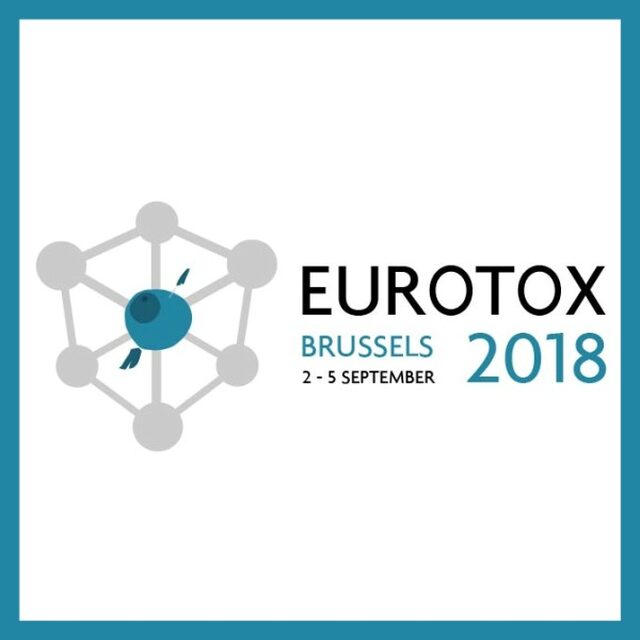Mattek Attending Eurotox 2018


The 54th annual Eurotox meeting will take place from September 2 – 5 in Brussels, Belgium. Mattek scientists from our US and EU locations attend this event every year to present new research and discuss new findings and methods in the field of in vitro toxicology. This year, our scientific staff are presenting four new posters on topics including inflammation in EpiIntestinal, an in vitro gut model, and the development of in vitro rat airway tissues to bridge the translational gap between animal models and in vitro human tissues.
Visit our staff and presenting authors at Booth #13

Dr. Patrick Hayden

Dr. Helena Kandarova

Dr. Silvia Letasiova

Dr. Jan Markus
View Our Posters
Modeling of Ligand-Induced Acute and Chronic Inflammation in the Gastrointestinal Tract Using In Vitro 3D Human Small Intestinal Microtissues
Jan Markus1,2, Timothy Landry1, Zachary Stevens1, Mitchell Klausner1, Patrick Hayden1, and Seyoum Ayehunie1
1Mattek Corporation, Ashland, MA; 2Mattek IVLSL, Bratislava, Slovakia.
Intestinal epithelium is known to be involved in innate immune responses by recognizing potential pathogens through cellular pattern recognition receptors (PRRs). The purpose of this study is to investigate PRR responses following exposure of an in vitro 3D human small intestinal (SMI) microtissue to various Toll-like receptor (TLRs) and Node-like receptor (NOD) ligands. The SMI microtissues are cultured using human intestinal fibroblasts and enterocytes and their 3-dimensional polarity and morphology mimics that of native in vivo tissues. Characterization of the microtissues included evaluation of structural features, barrier properties, and expression of drug transporters and drug metabolizing enzymes. Results showed that exposure of intestinal microtissues to live bacterial or ligands to TLR4 (LPS) and NOD2 (Muramyl dipeptide; MDP) were able to induce gene expression of proinflammatory cytokines such as IL-1β, IL-6, and RANTES. Prolonged exposure of intestinal microtissues to IL-1β also resulted in reduced membrane integrity and induction of pro-inflammatory cytokines (IL-6 and CCL20) known to stimulate acquired immune cell responses by inducing cytokine release such as TNF-α and IFN-γ or by initiating the migration of inflammatory cells. All these responses may be precursors for IBD-like disease. To simulate the effect of immune cell responses on the intestinal epithelium, we also exposed the microtissues to TNF-α and IFN-γ, which resulted in the reduction of membrane integrity and the release of proinflammatory cytokines. The effect of TNF-α and IFN-γ on the intestinal epithelium was further exacerbated if antigen-presenting cells such as dendritic cells were incorporated into the 3D intestinal microtissues. In summary, our results suggest that the EpiIntestinal tissue is capable of modeling innate immune responses and can be a useful tool to study the complex interactions of human intestinal epithelium with microbiome in vitro in the induction of IBD-like disease.
Abstract ID: 635 | Poster Number: P07-37
Poster Session: Emerging In Vitro Models
Viewing Session I
Monday, September 3
Author Attended 9:30AM – 10AM, 1PM – 2PM, 4PM – 4:30PM
Characterization of drug metabolizing enzymes, transporters and permeation in a human organotypic corneal tissue model
Kaluzhny2, M. Kinuthia2, T. Truong2, A. Lapointe2, M. Klausner2, S. Letasiova1, P. Hayden2
1Mattek In Vitro Life Science Laboratories, Bratislava, Slovakia, 2Mattek Corporation, Ashland, United States of America
The corneal barrier is vitally important for eye protection, but also presents a significant challenge for delivery of ophthalmic drugs. Most current studies utilize excised animal corneas that are not suitable for rapid drug screening and also have poor species extrapolation and standardization. We developed a physiologically relevant, human-based in vitro 3D corneal tissue model (EpiCorneal) and evaluated its utility for ophthalmic drug development.
Tissues were characterized by histology, confocal microscopy, barrier function, and expression of genes essential for metabolism, detoxification, and drug transport. The organotypic corneal tissue model developed tissue structure, thickness and barrier formation (1000±146 Ω•cm2) comparable to native human corneal epithelium. The 3D corneal tissue expressed tight junctions, mucins, and key corneal epithelial detoxification enzymes. qPCR arrays were utilized to investigate expression of 84 key phase I/II metabolizing enzymes and 84 drug transporter genes in 3D corneal tissue and excised human corneal epithelium. Drug metabolizing enzyme and transporter gene expression were highly correlated (r2=0.87).
Permeability was evaluated using model compounds with a wide range of hydrophobicity and molecular weight, and different formulations of glaucomatous drugs Latanoprost and Bimatoprost. Coefficients of permeation for model drugs in tissue model and excised rabbit corneas showed a high correlation (r2=0.94). As expected, Latanoprost and Bimatoprost free acids had much lower permeability (Papp=1.2×10-6 and 1.9×10-6) than the corresponding prodrugs (Papp=2.5×10-5 and 5.6×10-5, respectively). The presence of 0.02% Benzalkonium chloride in ophthalmic formulations significantly affected tissue barrier and viability.
In summary, the model demonstrates in vivo like structure, barrier and drug metabolizing and transporter gene expression. Tissue permeability, as well as effects on viability and barrier of various known ophthalmic formulations is similar to excised corneas. EpiCorneal tissue model may be useful in the evaluation of corneal drug permeability and safety during the development of new ophthalmics.
Keywords corneal epithelium, in vitro reconstructed tissue model, biocompartibility, ocular drug delivery, alternative to animal testing, drug metabolism, drug transport
Abstract ID: 713 | Poster Number: P07-42
Poster Session: Emerging In Vitro Models
Viewing Session I
Monday, September 3
Author Attended 9:30AM – 10AM, 1PM – 2PM, 4PM – 4:30PM
Inter- and intra-laboratory reproducibility of the in vitro photo-toxicity test using 3D reconstructed human epidermis model
H. Kandarova, A. Liskova, T. Milasova, S. Letasiova
Mattek In Vitro Life Science Laboratories, Bratislava, Slovakia
Assessment of the phototoxicity hazard and phototoxic potency (i.e. phototoxic risk) of compounds and mixtures is a crucial step in the safety assessment of cosmetic, pesticide and pharmaceutical products absorbing UV and visible light. The validated and regulatory accepted in vitro assay, the 3T3 NRU PT (OED TG 432), provides high level of sensitivity, however, it has been reported that it also generates high rate of false positive results due to the lack of barrier properties naturally appearing in the human skin or other targeted tissues.
In vitro reconstituted human skin models are increasingly being investigated for their usability in hazard identification and safety testing, because of their organotypic structure with a functional stratum corneum that allows for assessment of bioavailability of topically applied compounds and mixtures. An in vitro phototoxicity test using the human reconstructed epidermis model EpiDermTM (EpiDermTM H3D–PT) has been developed and pre-validated almost 20 years ago and can be used either as standalone method for the phototoxicity testing of topically applied materials, or in combination with the 3T3 NRU PT, to minimise the potentially false positive results from this assay.
In the current study we internally validated the method with six reference substances, of which four were known phototoxins (chlorpromazine hydrochloride, two types of bergamot oil and anthracene) and two compounds were UV-absorbing, but without phototoxic potential (cinnamaldehyde, p-aminobenzoic acid). In the next step the method has been transferred into the second laboratory and the test was assessed with another set of coded substances. The reproducibility of the predictions between the two laboratories was 100 % confirming the robustness of the protocol and the prediction model. Submission of the data for the implementation of the EpiDermTM H3D–PT into the regulatory framework is ongoing.
Keywords phototoxicity, reconstructed human skin model, validation, EpiDerm, regulatory toxicology
Abstract ID: 731 | Poster Number: P07-45
Poster Session: Emerging In Vitro Models
Viewing Session I
Monday, September 3
Author Attended 9:30AM – 10AM, 1PM – 2PM, 4PM – 4:30PM
Comparative Inhalation Toxicity Testing Using In Vitro Organotypic Rat and Human Airway Epithelial Models Abstract ID 499: Poster Number: P07-25
Patrick J. Hayden, George, R. Jackson, Jr., Joanne L. Vinall, Eleanor Storey, Hazel Simpson, Michelle Debatis, Anna Maione, Clive Roper and Mitchell Klausner
Rationale: Assessment of inhalation toxicity potential is important for developing new therapeutics and establishing safe handling, labeling and emergency response procedures for chemicals. Traditionally, animal models have been used for determining inhalation toxicity. However, in vivo models may not accurately predict human outcomes and therefore, translational information or replacement is increasingly required. To address this issue, in vitro organotypic airway tissue models constructed from primary human cells have been developed. Yet, validation of these systems is problematic because available in vivo inhalation toxicity data has been primarily produced using rodents. In the current project, a scalable in vitro organotypic model of rat mucociliary airway epithelium has been produced to allow direct comparison of chemical toxicity responses with previously developed in vitro human airway models. Methods: Conducting airways epithelial cells were isolated from CD rats, expanded in culture, and cultured at the air-liquid interface for up to 27 days. Comparison of toxicity responses in rat vs. human airway models was conducted using 14 chemicals with in vivo GHS inhalation toxicity classifications ranging from categories 1-5. The airway models were exposed to 4 doses of each test chemical for 3 hrs, followed by 21 hrs recovery prior to measurement of tissue viability. IC75 concentrations for chemical toxicity were determined from the dose response data. Results: Rat and human airway models demonstrated a high level of organotypic mucociliary differentiation including pseudostratified epithelial structure with copious development of functional cilia. Robust barrier function was demonstrated by development of transepithelial electrical resistance of up to 1000 Ω x cm2. Results of chemical toxicity experiments showed that rat and human tissue responses were similar, within the same order of magnitude, for each chemical. Future work will expand the range of chemicals tested to further define the comparative responses. Conclusions: These results suggest that in vitro rat airway and human airway models will be useful tools to facilitate rodent to human translation of in vitro inhalation toxicology data, and ultimately a more complete transition to human based in vitro models of inhalation toxicity.
Abstract ID: 499 | Poster Number: P07-25
Poster Session: Emerging In Vitro Models
Viewing Session I
Monday, September 3
Author Attended 9:30AM – 10AM, 1PM – 2PM, 4PM – 4:30PM

